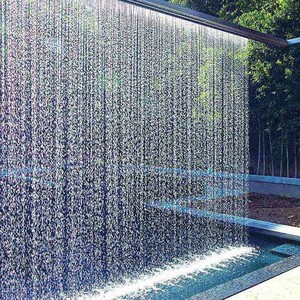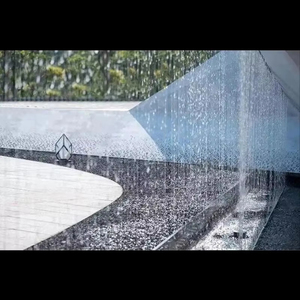(51876 products available)


























































































































































































Garden fountains are decorative features that add a touch of elegance and serenity to outdoor spaces. They come in various types, each offering unique visual and auditory experiences. Here are some common types:
Wall Fountains
These fountains are designed to be mounted on walls, making them ideal for smaller spaces or gardens with limited floor space. Wall fountains consist of a basin that collects the water, which is then recirculated back to the top. They are available in various materials, such as stone, metal, and ceramic, and can be powered by electricity or use a solar panel for water circulation.
Bird Bath Fountains
These fountains serve a dual purpose by attracting birds to the garden while adding an aesthetically pleasing element. They come in different styles and designs, ranging from simple and elegant to ornate and detailed. Typically, they are made from durable materials such as concrete, stone, metal, or resin, ensuring they can withstand various weather conditions. Bird bath fountains are powered by electricity or solar energy for water circulation, preventing stagnation and keeping the fountain clean.
Solar Fountains
Solar garden fountains are an environmentally friendly option that uses solar panels to power the water circulation system. They are easy to install as they do not require electrical wiring or batteries. These fountains are most effective in areas with ample sunlight. They are cost-effective over time, eliminating electricity bills associated with running the fountain.
Statue Fountains
These garden features combine the artistic appeal of a statue with the dynamic element of flowing water. They can depict various themes, such as mythological figures, animals, or abstract designs. The presence of water adds a captivating aspect to the statue, making it a popular choice for those looking to make a statement in their garden.
Tabletop Fountains
Small in size, these fountains are designed to be placed on tables, such as patio or deck tables. They still provide the soothing sound and visual appeal of running water without the space requirements of larger fountains. They can be made from different materials like ceramic, glass, stone, or resin. Tabletop fountains are usually self-contained, meaning they have a water reservoir that holds the water, preventing it from spilling over.
Tiered Fountains
These fountains feature multiple levels or tiers from which water cascades down. They are often made from materials such as stone, concrete, or marble. The water creates a soothing sound as it travels from tier to tier and can be a stunning focal point in any garden. They require a water source and circulation system, which can be electric or solar-powered.
When purchasing a water fountain for the garden, it is important to understand its features and functions. Here are some of them:
LED lights
Several garden fountains are equipped with LED lights. They are usually placed at the fountain's base or within the tiers. The lights illuminate the flowing water, creating attractive nighttime displays. They also add ambiance and beauty to the surrounding area. In larger fountains, the lighting system can be customized to include different colors and patterns.
Solar powered
Some garden fountains are solar powered. They use solar panels to capture the sun's energy and convert it into electricity. The electricity is then used to power the fountain's water pump. A solar powered fountain is eco-friendly and doesn't use electricity. It is also cheaper and safer to install because it doesn't have wires or cables. These fountains can only work well in areas that receive direct sunlight.
Recirculating water
Most garden fountains feature a recirculating water system. It consists of a water pump and a fountain reservoir. The pump draws water from the reservoir and pushes it to the top of the fountain. As water flows, it creates the desired effect as it spills and cascades down. The water then returns to the reservoir and the cycle continues. Since the fountain is self-contained, homeowners do not need to refill it often.
Adjustable water flow
Some garden fountains allow homeowners to customize the water flow. They can adjust the speed and the way the water trickles or cascades. This feature allows them to customize the water sound to their liking. Some may prefer a gentle trickle, while others may want a more pronounced sound. This can also help conserve water when a slower water flow is chosen.
Multiple tiers and bowls
Garden fountains can have multiple levels of bowls, also known as tiers. Each tier collects water from the one above it. They create a cascading effect as water flows from the top to the bottom. The more levels the fountain has, the more dramatic the water display is. This feature makes the fountain more attractive and eye-catching, enhancing the beauty of any garden where it is installed.
Aside from the function of garden fountain, they are also used for decorative purposes. It helps to make an environment look more beautiful and attractive. Here are some scenarios where garden fountains are used:
Public Parks and Squares:
In most public parks, there are garden fountains. These fountains serve different purposes. For instance, some of the fountains are used as a source of water for birds and other wildlife, while others provide a serene environment for park visitors. An example of such a fountain is the tiered fountain. This type of fountain can be used in both private and public spaces.
Hotels and Resorts:
Hotels and resorts make use of garden fountains to create a more welcoming atmosphere for their guests. This is done by installing these fountains in courtyards, lobbies, and outdoor spaces. The soothing sound of water can help reduce stress in guests, which may lead to improved overall wellness.
Religious Settings:
Garden fountains are used in some religious settings. They are used to symbolize spiritual nourishment and purity. They can also be found in the entrance of some religious buildings, where they serve as a means of ritual purification.
Therapeutic Environments:
Garden fountains are used in therapeutic environments like spas and wellness centers. The sound of the flowing water helps to create a calming atmosphere that encourages relaxation. This relaxation aids the process of treatments as it puts clients in the right frame of mind.
Commercial Spaces:
Some commercial spaces, like shopping malls and corporate offices, install garden fountains to enhance their aesthetics. The presence of a well-designed garden fountain can elevate the visual appeal of such spaces. This visual appeal can, in turn, attract more clients and customers.
Event Venues:
Event planners sometimes use garden fountains to beautify event spaces. This is done by installing portable garden fountains. These fountains can be removed after the event is over.
When choosing the ideal fountains for the garden, it’s important to consider a number of factors. Here are some key factors to consider before making any purchase:
Size and Scale:
Consider the size of the garden and the scale of the existing landscaping elements. A large and bold fountain may overpower a small garden, while a small fountain may get lost in a large garden. Choosing a fountain that complements the size and scale of the garden is important.
Material:
Garden fountains are made of different materials, such as stone, resin, fiberglass, and metal. Each material has its own advantages. For example, stone is strong and stays the same, but it costs more. Resin and fiberglass are lighter and easier to move, while metal can look modern or classic. When choosing a fountain, think about the style of the garden and how much time one wants to spend keeping the fountain in good shape.
Style and Design:
Garden fountains come in different styles, like classic, modern, or rustic. It's important to choose a style that goes well with the look of the garden and the house.
Budget:
Garden fountains have different prices, so it is important to choose one that fits the available budget. Remember that the cost of the fountain may also include extra things like water pipes, electric power lines, and people to set it up.
Maintenance:
All garden fountains need to be taken care of so they keep working well. They need to be cleaned and checked for problems. Larger fountains may need more work than smaller ones. Think about how much time and money one can spend on maintaining the fountain before choosing one.
Sound:
Think about how much water noise one wants to hear. Some fountains make a lot of noise as the water flows, while others are quieter. The noise level can affect the overall feel of the garden.
Q1: How does one choose the right size garden fountain?
A1: Consider the size of the garden and the scale of the objects around it. A large fountain can overwhelm a small garden, while a small fountain may get lost in a big space. Also, think about how the fountain will fit into the overall layout and design of the garden.
Q2: What are the most common materials used to make garden fountains?
A2: Garden fountains are typically made of stone, concrete, metal, or plastic. Stone and concrete are durable options that require little maintenance. Metal fountains add a stylish touch but may need to be protected from rust. Plastic fountains are lightweight and easy to move but may not last as long as other materials.
Q3: How does one maintain a solar-powered garden fountain?
A3: Solar-powered garden fountains are low maintenance, but they do need some care to keep the pump and panels working well. Clean the fountain and solar panels regularly to remove dirt and debris. This ensures maximum sunlight reaches the panels. In areas with harsh winters, take the fountain inside or cover it to protect it from the weather when not in use.
Q4: What is the best way to prevent algae growth in a garden fountain?
A4: To stop algae from growing in the garden fountain, keep the water moving and expose it to lots of sunlight. Cleaning the fountain regularly and using fountain-specific algaecides can also help control algae.
Q5: How can one make a simple tiered garden fountain?
A5: One can use a sturdy base like a large pot or container filled with stones. On top, stack smaller pots or containers in tiers, gradually getting smaller. Place a water pump inside the bottom tier and run the hose up through the center, so water flows from each tier. Decorate the pots with mosaics or paint if desired. Position it where it can be seen and heard. Fill it with water, and enjoy the soothing sounds!
The keyword "garden fountain" has experienced notable fluctuations in web search volume over the past year, with an average monthly web search volume of 14,800. Despite a three-month decrease of 33%, the year-long trend shows a significant increase of 50% in search interest. The data from the last twelve months illustrates a seasonal pattern, with peaks and valleys corresponding to different times of the year.
Analyzing the monthly search data for "garden fountain," the trend begins at 6,600 web searches in November and December 2023, then gradually rises to a peak of 33,100 web searches by June 2024. Following this peak, the web search volume shows a decline, returning to 14,800 web searches by August 2024. This pattern suggests a strong seasonal influence, likely tied to outdoor activities and gardening which are more common during warmer months.
The web search volume trend for "garden fountain" reflects a clear seasonal trend, with interest peaking during the summer months. This suggests that consumers are more likely to invest in garden enhancements like fountains when weather conditions are favorable for outdoor enjoyment and gardening. The significant increase over the past year could be attributed to a growing interest in home gardening and outdoor aesthetics, possibly influenced by trends toward home improvement and beautification projects.